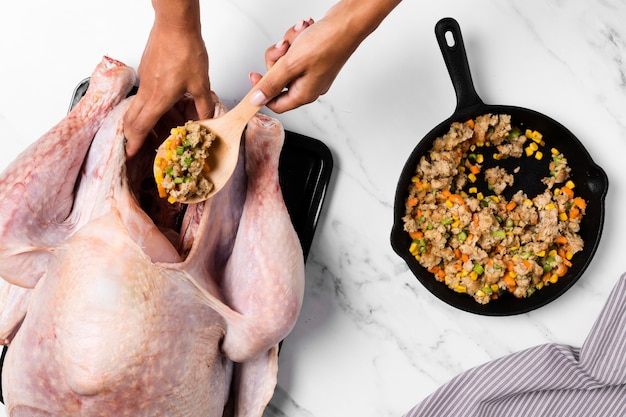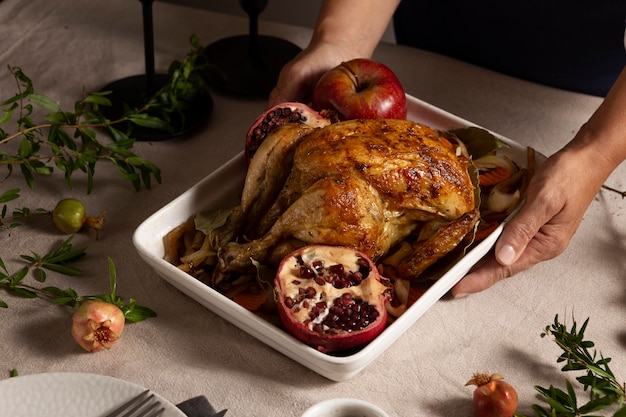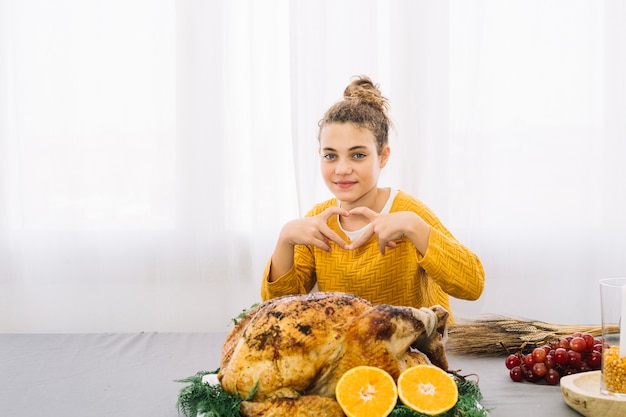Chicken legs! Those glorious, versatile little bits of poultry. They're a kitchen staple, whether you're roasting them for a Sunday dinner, grilling them for a barbecue, or frying them up for a quick weeknight meal.
As a seasoned cook, I've spent years experimenting with different methods and techniques, and I'm here to share all my secrets. This guide is more than just a bunch of recipes; it's an exploration of the world of chicken leg cooking, complete with personal anecdotes, tips, and tricks I've picked up along the way. Think of it as a chat with your favourite chef mate, except you get to learn a thing or two in the process.
So, grab a cuppa, settle in, and let's dive into the wonderful world of chicken leg cooking!
(Part 1) Understanding the Basics

chicken leg anatomy: A Primer
Before we get into the nitty-gritty of cooking, let's take a moment to appreciate the chicken leg's anatomy. It's not just one piece of meat, you know? There's the thigh, which is the larger, more muscular part, and the drumstick, which is the lower, bone-in portion.
Now, here's where things get interesting. The thigh contains more connective tissue than the drumstick, meaning it takes longer to cook and requires a slightly different approach.
The Importance of Temperature: It’s Not Just About the Time
You might be thinking, "Right, just tell me how long to cook it!" But hold your horses! Time isn't the only factor that determines how long your chicken legs need to cook. It's all about the temperature, my friend.
For chicken, we're aiming for an internal temperature of 165°F (74°C) to ensure it's cooked through and safe to eat. This is the golden rule, regardless of the cooking method.
Different Chicken Leg Sizes: One Size Doesn't Fit All
Chicken legs come in all shapes and sizes, from tiny little legs from young birds to massive ones from seasoned old birds. There’s no one-size-fits-all approach to cooking them.
That's why it's crucial to consider the size and weight of your chicken legs before setting the timer. A small leg will cook faster than a large one, so adjust your cooking time accordingly.
(Part 2) Cooking Methods for Chicken Legs

Now, let's talk about the different ways to cook chicken legs. Each method has its own advantages, so you can choose the one that best suits your needs and preferences.
1. Roasting: A Classic for a Reason
roasting chicken legs is a classic method that yields juicy, flavorful results. The key is to get the skin nice and crispy, which is a true sign of a perfectly roasted chicken leg.
Here's my tried-and-true method:
- Preheat your oven to 400°F (200°C). A hot oven ensures that the skin gets crispy quickly.
- Pat the chicken legs dry with paper towels. This will help the skin get nice and crisp. Then, rub them with olive oil and season generously with salt, pepper, and your favourite herbs and spices.
- Place the legs in a single layer on a baking sheet. This allows for even cooking and prevents steaming.
- Roast for 45-60 minutes, or until the internal temperature reaches 165°F (74°C). Remember to check the temperature with a meat thermometer.
- Let the chicken rest for 10 minutes before serving. This allows the juices to redistribute throughout the meat, making it even more tender and juicy.
2. Grilling: Summertime Delight
grilled chicken legs are perfect for outdoor entertaining. The smoky flavour adds another dimension to their deliciousness.
- Preheat your grill to medium-high heat. A hot grill ensures that the chicken gets nice grill marks.
- Pat the chicken legs dry and season with salt, pepper, and any other desired spices. I love to use a blend of paprika, garlic powder, and onion powder for a flavorful kick.
- Grill the legs for 5-7 minutes per side, or until they are cooked through and have nice grill marks. You'll know they're done when the juices run clear.
- Remove the chicken from the grill and let it rest for 5 minutes before serving. This allows the juices to redistribute.
3. Pan-Frying: Quick and Easy
For a quick and easy meal, pan-frying is the way to go. It's perfect for those nights when you don't have a lot of time.
- Heat some oil in a large skillet over medium-high heat. I like to use a combination of olive oil and butter for a richer flavour.
- Pat the chicken legs dry and season with salt, pepper, and any other desired spices. You can also add a sprinkle of flour for a crispy coating.
- Cook the chicken legs for 5-7 minutes per side, or until they are golden brown and cooked through. Be sure to cook them over medium-high heat to get a nice sear.
- Remove the chicken from the skillet and let it rest for 5 minutes before serving. This allows the juices to redistribute.
4. slow cooking: Tender and Juicy
For the ultimate in tender and juicy chicken, try slow cooking. It's a great way to cook chicken legs with minimal effort. The long cooking time breaks down the connective tissue in the thigh, resulting in incredibly tender meat.
- Place the chicken legs in your slow cooker. I often add some aromatics, like onions, garlic, and carrots, to the bottom of the slow cooker for extra flavour.
- Add your favourite sauce, vegetables, or herbs and spices. I love to make a simple sauce with chicken broth, soy sauce, honey, and ginger.
- Cook on low for 6-8 hours, or on high for 3-4 hours, until the chicken is tender and falling off the bone. The long cooking time ensures that the chicken is incredibly tender and flavorful.
- Serve the chicken with the delicious sauce it has simmered in. The sauce will have absorbed all the flavors from the chicken and vegetables.
5. Baking: A Simple and Versatile Choice
baking chicken legs is another great option, especially if you're making a large batch. It's a simple method that yields consistently delicious results.
- Preheat your oven to 375°F (190°C). This is a good all-around temperature for baking chicken legs.
- Pat the chicken legs dry, season with salt, pepper, and your favourite spices. You can also add herbs, garlic, or lemon juice for extra flavour.
- Place the legs in a single layer in a baking dish. If you want crispy skin, try placing them on a rack over a baking sheet to allow air to circulate around them.
- Bake for 45-60 minutes, or until the internal temperature reaches 165°F (74°C). You'll know they're done when the juices run clear.
- Let the chicken rest for 10 minutes before serving. This allows the juices to redistribute.
(Part 3) Flavour Boosters: Beyond Salt and Pepper

You can make even the simplest chicken leg recipe sing by experimenting with different seasonings. Here are some of my go-to combinations:
- Mediterranean: Lemon juice, garlic, oregano, thyme, and a pinch of red pepper flakes. This combination creates a bright, citrusy flavour with a hint of spice.
- Asian-Inspired: Soy sauce, ginger, garlic, sesame oil, and a touch of honey. This combination brings a sweet and savory flavour with a hint of ginger and sesame.
- Spicy: Smoked paprika, cayenne pepper, chili powder, and cumin. This combination creates a warm, smoky flavour with a kick of heat.
- Herby: Fresh rosemary, thyme, sage, and parsley. This combination provides a classic, earthy flavour that complements chicken beautifully.
- Garlic Lovers: Crushed garlic, garlic powder, and a touch of lemon zest. This combination delivers a powerful garlic flavour with a touch of brightness from the lemon zest.
The Power of Marinades: Take Your Chicken to the Next Level
For an extra flavour kick, try marinating your chicken legs before cooking. A marinade is like a magic potion that infuses the meat with flavour and helps to keep it moist.
- Citrus Marinades: Combine citrus juice (lemon, lime, orange), olive oil, herbs, and spices. Marinate for at least 30 minutes, or up to 24 hours. This combination creates a bright, citrusy flavour with a hint of herbs and spices.
- Soy-Based Marinades: Mix soy sauce, mirin, rice wine vinegar, ginger, garlic, and sesame oil for a delicious Asian-inspired flavour. This combination delivers a sweet and savory flavour with a hint of ginger and sesame.
- Spicy Marinades: Incorporate chili flakes, cayenne pepper, paprika, and garlic for a fiery kick. This combination creates a warm, smoky flavour with a kick of heat.
- Herb-Based Marinades: Blend fresh or dried herbs like thyme, rosemary, oregano, and basil with olive oil and lemon juice. This combination provides a classic, earthy flavour that complements chicken beautifully.
The Finishing Touches: Adding a Touch of Magic
After you've cooked your chicken, don't forget about the finishing touches. They can make a world of difference.
- Lemon Juice: A squeeze of fresh lemon juice adds a bright, tangy flavour that cuts through the richness of the chicken.
- Herbs: Chopped fresh herbs like parsley, cilantro, or basil add freshness and flavour. They provide a burst of freshness and fragrance.
- Butter: A pat of butter adds richness and moisture. It helps to create a succulent and flavorful chicken leg.
- Honey Glaze: Brush the chicken with a honey glaze for a sweet and sticky finish. The honey glaze adds a touch of sweetness and a beautiful gloss to the chicken.
(Part 4) Chicken Leg Cooking Time Guide: A Cheat Sheet
Table: Average Cooking Times for Chicken Legs (Based on Weight)
| Weight | roasting time (400°F) | Grilling Time (Medium-High) | Pan-Frying Time (Medium-High) | Baking Time (375°F) |
|---|---|---|---|---|
| 1-2 lbs (450-900g) | 45-60 minutes | 10-15 minutes | 10-15 minutes | 45-60 minutes |
| 2-3 lbs (900-1.4kg) | 60-75 minutes | 15-20 minutes | 15-20 minutes | 60-75 minutes |
| 3-4 lbs (1.4-1.8kg) | 75-90 minutes | 20-25 minutes | 20-25 minutes | 75-90 minutes |
Remember:
- These are just estimates, and cooking times can vary depending on the size and shape of your chicken legs, the heat of your oven, and other factors. Always check the internal temperature to ensure the chicken is cooked through.
- Use a meat thermometer to ensure your chicken legs are cooked to an internal temperature of 165°F (74°C). This is the most accurate way to ensure that your chicken is cooked safely.
- Don't be afraid to adjust the cooking time based on your preferences. For example, if you want your chicken legs to be extra crispy, you can roast or bake them for a little longer.
(Part 5) The chicken leg leftovers: Don't Waste a Bite!
Don't let those delicious leftover chicken legs go to waste! They're a blank canvas for a whole new batch of culinary delights.
1. chicken salad: A Classic with a Twist
Mix shredded chicken with mayonnaise, celery, onion, and your favourite herbs and spices. You can add chopped nuts, dried cranberries, or grapes for extra flavour and texture.
2. Chicken Soup: A Warm and Comforting Meal
Use leftover chicken legs to make a hearty and flavorful chicken soup. Simply simmer the chicken with vegetables, broth, and your favourite spices. It's a perfect way to use up leftovers and create a comforting meal.
3. Chicken Quesadillas: A Speedy and Delicious Dinner
Combine shredded chicken with cheese, salsa, and your favourite toppings for a quick and satisfying quesadilla. It's a great way to use up leftovers and make a delicious lunch or dinner.
4. Chicken Enchiladas: A Hearty and Savoury Dish
Use leftover chicken to make enchiladas filled with your favourite ingredients, such as cheese, beans, and salsa. It's a hearty and flavorful dish that's perfect for a crowd.
5. Chicken Stir-Fry: A Flavorful and Easy Meal
Chop the leftover chicken into bite-sized pieces and add it to your favourite stir-fry. It's a quick and easy way to use up leftovers and create a flavorful meal.
(Part 6) Chicken Leg cooking tips: Tricks of the Trade
Here are some tips that will help you cook the most delicious chicken legs every time.
1. The Importance of Brining: A Secret to Tenderness
Brining your chicken legs before cooking is a great way to lock in moisture and create a succulent result. Simply submerge the legs in a salt water solution for 30 minutes to 24 hours. The salt draws moisture out of the chicken and then back in, resulting in more tender and flavorful meat.
2. Don't Overcrowd the Pan: Space is Key
When you're cooking chicken legs, make sure they have plenty of space in the pan or on the baking sheet. Overcrowding can lead to uneven cooking and steaming rather than browning. Give each chicken leg some breathing room so it can cook evenly and develop a crispy skin.
3. Resting Time: Let the Juices Redistribute
Allow your chicken legs to rest for 5-10 minutes after cooking. This gives the juices a chance to redistribute throughout the meat, resulting in a more tender and flavorful chicken. Don't skip this step, it makes a real difference!
4. The Power of a Meat Thermometer: No More Guesswork
Invest in a good quality meat thermometer. It's the most accurate way to ensure your chicken legs are cooked to perfection. It eliminates the guesswork and ensures that your chicken is cooked safely.
5. Don't Be Afraid to Experiment: Taste is Subjective
Don't be afraid to experiment with different cooking methods, seasonings, and recipes. The beauty of cooking is that there’s no right or wrong way. Have fun and find what you like best. The best cooks are the ones who aren't afraid to try new things and find what works for them.
(Part 7) Chicken Leg Mishaps: What to Do When Things Go Wrong
We've all been there: you're cooking up a batch of chicken legs, and something goes wrong. Don't worry, it happens to the best of us! Here are some tips to help you troubleshoot and salvage those chicken legs:
1. Dry Chicken Legs: Reversing the Situation
If your chicken legs turn out dry, it's probably because they were overcooked. To salvage them, you can try adding a sauce or gravy to rehydrate them. You can also add them to a soup or stew, where the extra liquid will help to make them tender.
2. Over-Seasoned Chicken: A Fixable Issue
If you've over-seasoned your chicken, there's not much you can do to fix it. However, you can try serving it with a side dish that has a milder flavour to balance out the saltiness. A side of rice or a salad can help to cut through the saltiness.
3. Chicken That's Not Cooked Through: Safety First
If your chicken legs aren't cooked through, it's important to return them to the oven or on the grill until they reach an internal temperature of 165°F (74°C). Don't eat raw or undercooked chicken. It's always better to be safe than sorry!
(Part 8) Chicken Leg FAQs: Answers to Your Questions
1. Can I cook chicken legs from frozen?
Yes, you can cook chicken legs from frozen, but it will take longer. It's best to defrost them in the refrigerator overnight before cooking. This ensures that the chicken is cooked evenly and safely.
2. What are the best side dishes to serve with chicken legs?
Chicken legs go well with a variety of side dishes, such as mashed potatoes, roasted vegetables, green beans, rice, and salads. Choose sides that complement the flavours of your chicken and create a balanced meal.
3. How can I store leftover chicken legs?
Store leftover chicken legs in an airtight container in the refrigerator for up to 3-4 days. This helps to prevent the chicken from drying out and keeps it fresh.
4. Can I freeze leftover chicken legs?
Yes, you can freeze leftover chicken legs for up to 3 months. To freeze them, place them in a freezer-safe bag or container. This is a great way to extend the life of your leftovers and have them ready for another meal.
5. What are the best tips for making crispy chicken skin?
To get crispy chicken skin, make sure the chicken legs are completely dry before cooking. You can also place them on a rack over a baking sheet or in a skillet with a little bit of oil. This will help the skin to crisp up evenly.
Everyone is watching

Corn on the Cob: The Ultimate Guide to Perfectly Cooked Ears
Healthy MealsAh, corn on the cob. Just the name evokes images of sunny days, barbecues, and that sweet, juicy flavour that ...

Perfect Pork Roast Oven Cooking Time: A Guide to Delicious Results
Healthy MealsThere's something truly satisfying about a perfectly roasted pork. The aroma alone is enough to make your mout...

Ham Cooking Time: How Long to Bake, Smoke, or Boil a Delicious Ham
Healthy MealsAh, ham. It's a classic, isn't it? A real crowd-pleaser, especially around holidays. And when done right, it'...

Scallops: The Ultimate Guide to Perfect Cooking
Healthy MealsAh, scallops. Those delicate, sweet, and utterly delicious morsels of the sea. They hold a special place in my...

Spaghetti Squash: The Ultimate Guide to Cooking and Serving
Healthy MealsRemember that time you saw spaghetti squash at the supermarket, looking all bumpy and strange, and thought, "W...
